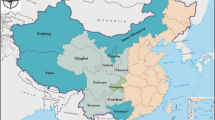Abstract
Sustainable development in China is under increasing pressure from rapid population growth and economic activities in recent decades. Despite the growing awareness and invested efforts, there is a lack of understanding of the progress, trade-offs, and spatiotemporal variations of sustainability across China. This paper investigates the spatial and temporal variations of sustainability in Mainland China from 2004 to 2014. An evaluation framework involving 21 indicators, which are grouped under the three categories of economic, social, and environmental performance, is proposed for evaluating the Sustainability Index (SI) for 31 provincial-level divisions in China. Balancing the ‘triple bottom line’ performance to achieve sustainability is an ideal goal, which is analyzed for each geographical region in China. The ideas of the analytic hierarchy process have been used under four different scenarios to investigate trade-offs among the three performance areas and reveal the impacts of indicator weights on the assessment results. Results obtained show marginal improvement in sustainability across China when social and environmental factors are considered to be more important than economic ones, while a significant improvement is observed when economy is considered to be more important. The indicator weights have a clear impact on the assessment of SI, but the influence is reduced when the results for 2004 and 2014 are compared. This study provides an enhanced understanding of spatial and temporal variations in regional sustainability in China, providing more evidence for informed decisions on regional economic, social and environmental development.





Similar content being viewed by others
References
Alberto C, Bork S (2016) Methodological tools for assessing the sustainability index (SI) of industrial production processes. Int J Adv Manuf Technol 87:1313–1325
Asian Development Bank (2013). Asian development outlook 2013
Ding G, Yu J, Liu F (2016a) Water shortage and pollution in China. Acad J Environ Sci 4:018–019
Ding L, Shao Z, Zhang H, Xu C, Wu D (2016b) A comprehensive evaluation of urban sustainable development in China based on the TOPSIS-entropy method. Sustainability 8:1–23
Hara K (2017) Sustainability trend in China and prospects of assessment methodology. Sustain Sci 12:887–890
Holdren JP (2008) Science and technology for sustainable well-being. Science 319:424–434
Hong W, Jiang R, Yang C, Zhang F, Su M, Liao Q (2016) Establishing an ecological vulnerability assessment indicator system for spatial recognition and management of ecologically vulnerable areas in highly urbanized regions: a case study of Shenzhen, China. Ecol Indic 69:540–547
Kuhlman T, Farrington J (2010) What is sustainability? Sustainability 2(11):3436–3448
Li A, Wang A, Liang S, Zhou W (2006) Eco-environmental vulnerability evaluation in mountainous region using remote sensing and GIS—a case study in the upper reaches of Minjiang River, China. Ecol Model 192(1–2):175–187
Li T, Zhang H, Yuan C, Liu Z, Fan C (2012) A PCA-based method for construction of composite sustainability indicators. Int J Life Cycle Assess 17:593–603
Liu D, Cao C, Dubovyk O, Tian R, Chen W, Zhuang Q, Zhao Y, Menz G (2017) Using fuzzy analytic hierarchy process for spatio-temporal analysis of eco-environmental vulnerability change during 1990–2010 in Sanjiangyuan region, China. Ecol Indic 73:612–625
Lu Y, Geng Y, Liu Z, Cote R, Yu X (2017) Measuring sustainability at the community level: an overview of China’s indicator system on National Demonstration Sustainable Communities. J Clean Prod 143:326–335
Miao CL, Sun LY, Yang L (2016) The studies of ecological environmental quality assessment in Anhui Province based on ecological footprint. Ecol Indic 60:879–883
Munier N (2011) Methodology to select a set of urban sustainability indicators to measure the state of the city, and performance assessment. Ecol Indic 11:1020–1026
Mustapha MA, Manan ZA, Rafidah S, Alwi W (2016) A new green index as an overall quantitative green performance indicator of a facility. Clean Technol Envir 18:2161–2171
Shi B, Yang H, Wang J, Zhao J (2016) City green economy evaluation: empirical evidence from 15 sub-provincial cities in China. Sustainability 8(6):551
Sikdar SK, Sengupta D, Mukherjee R (2017) Measuring progress towards sustainability: a treatise for engineers. Springer, Cham
Su B, Heshmati A, Geng Y, Yu X (2013) A review of the circular economy in China: moving from rhetoric to implementation. J Clean Prod 42:215–227
United Nations (1997) Agenda for development. United Nations, New York
Wang SX, Yao Y, Zhou Y (2014) Analysis of ecological quality of the environment and influencing factors in China during 2005–2010. Int J Environ Res Public Health 11:1673–1693
Wei X, Qiao Y, Wang P (2010) Dynamic monitoring of ecological environment based on remote sensing and GIS-taking Xiangning county, Shanxi Province as an example. J Geo-Inf Sci 1:111–118
Yan Y, Wang C, Quan Y, Wu G, Zhao J (2018) Urban sustainable development efficiency towards the balance between nature and human well-being: connotation, measurement and assessment. J Clean Prod 178:67–75
Zhang S, Wei Z, Liu W, Yao L, Suo W, Xing J, Huang B, Jin D, Wang JS (2015) Indicators for environment health risk assessment in the Jiangsu Province of China. J Int J Environ Res Public Health 12:11012–11024
Zhao FJ, Ma Y, Zhu YG, Tang Z, McGrath SP (2014) Soil contamination in China: current status and mitigation strategies. Environ Sci Technol 49:750–759
Acknowledgements
This work was partially funded by the State Key Laboratory of Urban Water Resources and Environment, Harbin Institute of Technology (No. 2016TS02), Heilongjiang Province Science Foundation for General Programme (No. E201427) and China Scholarship Council (CSC).
Author information
Authors and Affiliations
Corresponding author
Rights and permissions
About this article
Cite this article
Qiu, W., Meng, F., Wang, Y. et al. Assessing spatial and temporal variations in regional sustainability in mainland China from 2004 to 2014. Clean Techn Environ Policy 20, 1185–1194 (2018). https://doi.org/10.1007/s10098-018-1540-4
Received:
Accepted:
Published:
Issue Date:
DOI: https://doi.org/10.1007/s10098-018-1540-4




